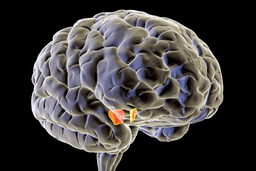Objective Method to Select Optimal Trajectories in DBS
TECHNOLOGY NUMBER: 2021-309

OVERVIEW
A method to optimize trajectory for deep brain stimulation (DBS) in Parkinson's Disease- A novel approach that differs from the reliance on the span of substantia nigra (STN) traversed
- Yields a predicted 8% improvement in motor outcomes following STN DBS
BACKGROUND
Deep brain stimulation (DBS), a surgical procedure for Parkinson's Disease, can help ease motor symptoms and decrease medication needs in some people. The process of DBS involves implanted electrodes that stimulate specific areas in the brain to manage the manifestations of Parkinson's Disease including essential tremor, dystonia, obsessive compulsive disorder, and epilepsy. A major challenge in the performance of deep brain stimulation surgery is the selection of an optimal surgical trajectory. Choosing among several anatomic trajectories is typically done by selecting the approach traversing the longest span of the affected part of the brain, called the substantia nigra (STN). A need exists to determine the optimal stimulation region along a given electrode trajectory through the brain when performing DBS.
INNOVATION
Researchers at the University of Michigan have demonstrated a method that scores trajectories for DBS according to electrophysiological recordings. The investigators integrated microelectric recordings (MER) and spatial information about optimal stimulation volumes (VTAs) to develop a patient-specific MER-based metric to evaluate the effectiveness of a DBS trajectory more accurately than an STN span metric. Their data suggests that in an appropriately chosen patient group the objective method for choosing trajectory would improve clinical outcomes by 8%. The method also reduces the complexity of trajectory selection and may speed up and simplify STN DBS surgery for neurosurgeons.